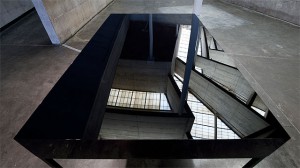In a 1957 lecture entitled Experimental Music, artist John Cage posited that sound, be it cacophonic or melodic, is always with us. Further, he suggested that silence does not exist, as we are aware of the ambient noise that plays in the background of our daily lives. Cage’s experimentation was intended, at least in part, to draw our attention to the information that our senses — sight, smell, touch, and sound — deliver through the most primal of means. When those sensate experiences are challenged, our perception is also questioned. For MATRIX 249, artist Zarouhie Abdalian presents objects that challenge us, with equal measure of playfulness and menace, to take stock of our perceptions and how we interpret the information they provide.
Installed in Gallery A on the museum’s lower level, Abdalian’s multifaceted practice is represented by a trio of objects that interact with each other, but only on the most minimal terms. First seen, first heard really, is the pervasive knocking emitted by the piece Each envelope as before. The object — a rectangular vitrine, polished black and as enigmatic as the monoliths in Stanley Kubrick’s 2001 — stands nearly four feet off the ground. The reflective surface does not allow one to identify the inner workings of the piece, leaving us to reckon with its combined inertness and animation via sound. Up close, the sound quality is pristine. At times, you can hear the internal mechanisms activating to drive the hammers against the walls of the vitrine. By comparison, and without surprise, the knocking becomes more diffuse when heard at a distance. The passage of sound through the nearly empty space is unhindered, its only barriers being the gallery’s dense concrete walls and any other bodies or objects present. Given enough time in the gallery, one becomes accustomed, maybe irritated, by the rhythmic beats. As I walked around, away from, and toward the vitrine, my mind made disparate lists of what makes a similar sound — video games droning, clocks ticking, armies marching…
 Zarouhie Abdalian, Each envelope as before, 2013.
Zarouhie Abdalian, Each envelope as before, 2013.
 Zarouhie Abdalian, As a demonstration, 2013.
Zarouhie Abdalian, As a demonstration, 2013.
As a demonstration, positioned opposite the vitrine, consists of a clear plexiglass chamber that houses an alarm bell. We see the miniature steel hammer strike the shiny brass bell and experience tells us that a sound should be released, but there is nothing for us to hear. The ringing is absorbed within the vacuum-sealed silence, effectively blasting Cage’s assertion that silence is impossible. In other words, we see but do not hear, which is exactly the opposite experience of the companion object wherein we hear but do not see. I spent nearly ninety minutes in the gallery, and the longer I was there, the more obsessively I found myself looking at the bell to see if the hammer strike would align with the pervasive knocking. Twice was that desire fulfilled, yet the dissonance of what I saw and expected to hear was disorientingly complete.

 Zarouhie Abdalian, Ad Libitum (If I Had a Hammer), 2013.
Zarouhie Abdalian, Ad Libitum (If I Had a Hammer), 2013.
